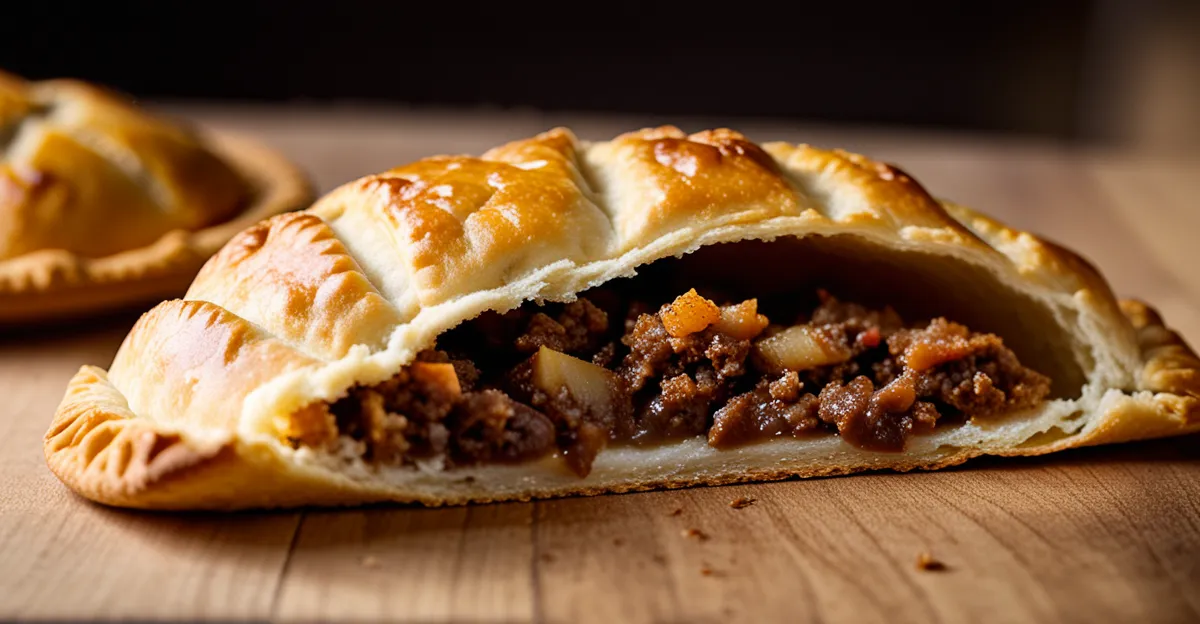Essential Ingredients for Flaky Cornish Pasty Pastry
When crafting Cornish pasty pastry, selecting the best flour for pastry is crucial to achieving that signature flaky texture. Typically, a flour with moderate protein content, such as plain or all-purpose flour, strikes the perfect balance. This protein level provides enough gluten development to hold the pastry together without making it tough. Using too high-protein flour results in a chewy crust, detracting from the desired flakiness.
Another significant factor lies in traditional fat choices. The classic approach involves using a blend of lard and butter. Lard contributes superior flakiness due to its unique fat crystal structure, while butter adds rich flavor and tenderness. Some bakers prefer pure butter for taste or pure lard for texture, but combining both often yields the best results. The fat should be cold and incorporated carefully to create distinct layers that puff slightly when baked, delivering that sought-after crispness.
In parallel : How do you prepare a hearty steak and kidney pie from scratch?
Lastly, the importance of fresh, high-quality ingredients cannot be overstated. Fresh flour and butter ensure consistent results, while aged or stale ingredients may compromise dough elasticity and flavor. The freshness of the flour affects how well it absorbs fat and how the dough responds to handling, especially in pasty making, where structure and texture are paramount.
Mastering these essential ingredients establishes the foundation for a flaky, authentic Cornish pasty pastry. Combining the right flour, traditional fats, and fresh materials sets the stage for excellent pasty making and delicious outcomes every time.
Also to read : How Does Traditional British Cuisine Impact Modern UK Eating Habits?
Mastering the Pastry Technique
Mastering pastry folding, chilling, and handling is critical to achieving the ideal flaky texture in a Cornish pasty pastry. One of the most important steps is pastry chilling. After mixing, the dough must rest and chill for at least 30 minutes in the refrigerator. Chilling solidifies the fats and relaxes gluten strands, allowing the dough to roll out smoothly without shrinking and maintains distinct fat layers that create flakiness during baking.
The folding and laminating methods used in pasty making techniques are unique compared to other pastries. Rather than fully incorporating fat into the dough, small chunks of cold fat remain visible in the dough layers. During rolling and folding, these fat pockets separate the flour layers, creating the characteristic crisp, flaky texture when baked. Folding too many times can cause the layers to merge, reducing flakiness, so a careful balance is necessary.
Avoiding overworking the dough is also vital. Excessive handling develops too much gluten, which can result in a tough, dense pastry rather than a tender, flaky crust. Working the dough just enough to combine ingredients and then resting it prevents this common mistake. Overall, well-executed pastry folding, strategic chilling, and gentle handling form the backbone of professional pasty making techniques, securing both structure and delicate flakiness in every Cornish pasty.
Baking Secrets for Perfect Flakiness
Achieving perfect Cornish pasty baking begins with mastering the oven environment. The oven temperature for pasties is critical; preheating to around 220°C (425°F) allows the pastry fat to melt swiftly, creating steam that separates layers and enhances flakiness. After initial baking, lowering the temperature to about 180°C (350°F) ensures thorough cooking without overbrowning, preserving the delicate crispiness.
Applying an egg wash before baking is a vital step for an appetizing, golden finish. Use a lightly beaten egg, sometimes mixed with a little water or milk, and brush it evenly over the pastry surface. This coating encourages even browning and adds subtle shine, signaling a perfectly baked pasty. Avoid thick layers of egg wash as this can dampen the crisp texture.
Recognizing the signs of perfect doneness involves observing both appearance and tactile qualities. The pastry should be uniformly golden, with edges crisp but not burnt. Gently tapping the surface reveals a firm, flaky crust that yields slightly under pressure. If the pasty feels doughy or pale, it needs more time; too dark or overly hard indicates overheating.
Together, precise control of oven temperature for pasties, thoughtful use of egg wash tips, and an eye for doneness contribute significantly to the flaky texture and beautiful presentation expected in traditional Cornish pasty baking.
Avoiding Common Mistakes in Pasty Making
Mistakes in pasty making can significantly impact the flaky texture and overall quality of your Cornish pasty pastry. One of the most frequent pasty making mistakes is overmixing the dough. Overworking develops excessive gluten, leading to a tough, dense crust rather than the desired tender flakiness. The best approach is combining ingredients just until they come together, followed by adequate resting time. This prevents toughness and ensures the dough remains pliable for shaping.
Under-resting the dough is another common pitfall that compromises structure. Insufficient chilling prevents fats from solidifying and gluten from relaxing, resulting in shrinkage and uneven flakiness during baking. Proper pastry chilling of at least 30 minutes is essential for maintaining layer separation and crispness.
Overfilling pasties causes seals to break during baking, leading to filling leaks and soggy edges. Conversely, undersealing can cause similar problems, where steam escapes and layers fail to build properly. Ensuring precise and secure sealing helps maintain texture and prevents moisture loss.
Incorrect fat-to-flour ratios are a subtle yet critical factor. Using too much fat creates greasy dough that lacks structure; too little yields dry, crumbly results. The right balance must be struck, especially with traditional fat choices like lard and butter, to achieve both rich flavor and flaky layers. Attention to these common issues is vital for pastry fail prevention and producing consistently excellent Cornish pasties.
Traditional vs. Modern Approaches to Flaky Pasties
Exploring traditional Cornish pasty methods reveals time-honored techniques that focus on simplicity and authenticity. Classic pastry making relies on hand-rolling and folding to create distinct, flaky layers without overworking the dough. The use of lard and butter in the fat blend remains central, preserving the rich texture and flavor that define the traditional Cornish pasty pastry. These methods often require patience, as resting and chilling intervals are strictly observed to enhance dough elasticity and flakiness. Hand-sealing pasties by crimping dough edges ensures a sturdy seal, preserving the filling’s moisture during baking.
On the other hand, modern pastry innovations incorporate conveniences like food processors for mixing dough and pre-made fats designed to mimic lard’s properties. Some adaptations replace animal fats with vegetable-based alternatives to accommodate dietary preferences, though this can affect the characteristic flakiness and richness. Innovative techniques may include layered lamination inspired by puff pastry to boost flakiness, but can risk deviating from the original texture if overdone. Speedier chilling methods, such as quick freezing, offer time savings but require careful control to prevent fat melting and reduced layering.
When comparing results between traditional and modern approaches, the key differences lie in texture and taste. Traditional methods typically produce a pasty with a sturdier, more crumbly crust featuring nuanced buttery and savory notes. Modern versions often trade some depth of flavor for convenience or dietary concerns, occasionally resulting in a lighter or less textured crust. However, thoughtful use of modern innovations can uphold flaky qualities if they respect core pasty making techniques like controlled folding and chilling. Ultimately, choosing between these approaches depends on priorities—authenticity and richness versus efficiency and adaptation—each affecting the cornerstones of Cornish pasty pastry craftsmanship.






